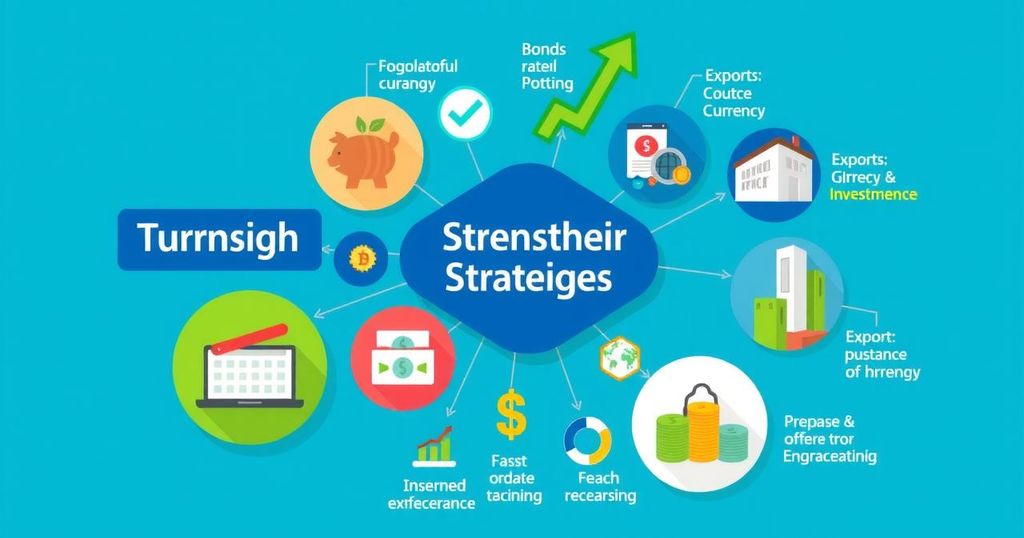Five months ahead of crucial midterm elections, President Javier Milei focuses his campaign on strengthening the peso to combat inflation and boost his party’s chances. Implementing measures such as lifting currency controls, promoting soybean exports, and attracting foreign investment, his administration aims for a stronger economy. However, analysts express concerns about potential risks and the sustainability of these initiatives.
In Argentina, five months ahead of significant midterm elections, President Javier Milei has put the peso at the forefront of his campaign strategy. He perceives the currency as a crucial instrument to combat inflation and enhance his party’s prospects in the upcoming October vote, pushing his team to implement aggressive measures aimed at bolstering the peso’s value.
Milei has recently introduced a trading band after partially lifting currency controls for individuals. Since April 14, the peso has consistently traded below the midpoint of this band, initially set between 1,000 and 1,400 pesos per US dollar. The band allows for a one percent monthly deviation, which is intended to limit depreciation and curb the inflation that many analysts expect.
Luis Caputo, the Economy Minister, remarked last week during a meeting with business leaders that, “The model of a miserable Argentina, given away in dollars, is over.” A stronger peso could potentially instill optimism in Argentina’s citizens regarding their economic future. However, some analysts worry it could also weaken profit margins and competitiveness.
Alejandro Cuadrado, head of currency strategy for Latin America at BBVA, stated, “The peso had already appreciated in real terms, so strengthening it would deepen that trend.” There are several steps, also, that Milei’s administration is taking to further enhance the peso’s strength.
Firstly, the seasonal soy exports could play a role in this effort. The soybean harvest typically results in a surge of dollar influx in the second quarter, which could be bolstered by the expiration of a tax exemption for agricultural exports at the end of June. This moves soybean producers closer to Milei’s goals.
Secondly, in a recent television interview, Federico Furiase, a director at Argentina’s Central Bank, announced plans to issue peso-denominated bonds purchasable in dollars. This initiative aims to help the monetary authority build its reserves further.
Additionally, new regulations now allow foreign investors to access the official exchange market provided they maintain their investments in Argentina for at least six months. This regulatory change is attracting foreign capital seeking profits in pesos.
Caputo is also promoting an amnesty for savers in an effort to bring nearly US$200 billion currently hoarded outside the banking system back into circulation. The goal is to get more Argentines to utilize and conduct transactions with these funds. More information about this initiative is expected to be revealed in the coming days.
Energy exports are also on the rise; they might soon become Argentina’s second-largest source of foreign exchange after agriculture, particularly through the Vaca Muerta oil field. The administration anticipates that with the free market dynamics, foreign direct investment will increase, leading firms to import more dollars. Nevertheless, foreign investment remains hesitant during Milei’s presidency.
The government plans to adhere to a fiscal surplus to withdraw pesos from circulation, hence minimizing demand for dollars and alleviating any pressure on the exchange rate, according to Furiase. Furthermore, the Central Bank has opted not to buy dollars until the peso shows signs of strengthening, also indicating plans to issue a dollar-denominated bond for companies intending to remit dividends abroad.
The steps taken by Milei’s government signify a commitment to uphold the peso’s value. After enduring years of criticism, especially as the currency was once disparagingly referred to as “excrement” by Milei during his campaign, the Central Bank believes the peso now stands as one of the best-performing currencies in 2024 after inflation adjustments.
However, continuing to strengthen the currency is not without risks. Cuadrado warned that pushing the peso down to its lower band would need to be avoided given the nation’s obligations tied to its International Monetary Fund financing agreement.
Milei’s administration aims to improve the purchasing power of Argentine wages in real terms. Yet, some analysts caution that a strong peso could diminish activity in certain sectors and lead to inflationary expectations. ”This could create a window of opportunity to buy dollars,” said Federico Filippini, chief economist at Adcap, arguing that as long as the government remains focused on its inflation target, this trend can be sustained.
On a separate note, business leaders convened in Buenos Aires recently, advocating for tax cuts. Manuel Santos Uribelarrea, CEO of electricity generator MSU, expressed concerns about how various economic factors such as high taxes and a strong exchange rate are stifling growth across different sectors.
In summary, as midterm elections approach, Javier Milei’s administration is implementing a series of strategies aimed at strengthening the peso and enhancing economic prospects in Argentina. By fostering seasonal exports, encouraging foreign investment, and lifting certain currency controls, the government hopes to instigate a robust economic environment. However, there are concerns regarding the long-term sustainability of these measures and their potential impact on sectoral performance and inflation. The situation remains precarious as business leaders call for tax reforms to support growth amidst these challenges.
Original Source: www.batimes.com.ar






